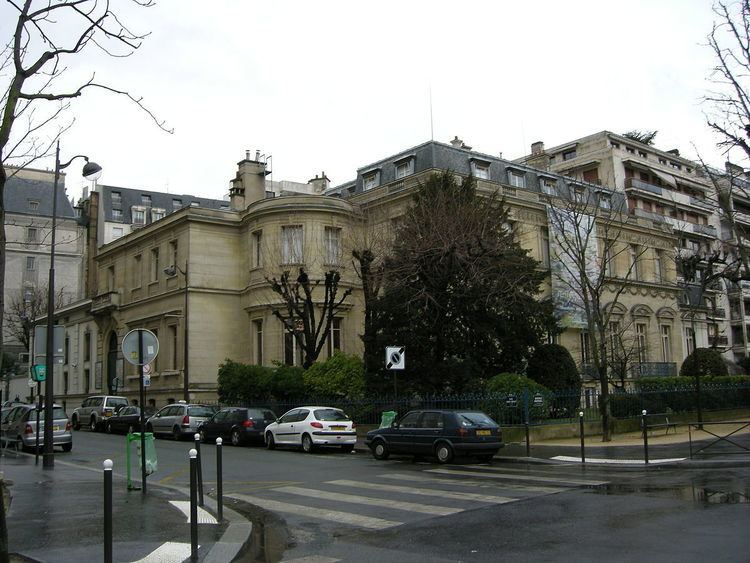Established 1934 Founded 1934 | Phone +33 1 44 96 50 33 | |
 | ||
Hours Closing soon · 10AM–6PMWednesday10AM–6PMThursday10AM–9PMFriday10AM–6PMSaturday10AM–6PMSunday10AM–6PMMondayClosedTuesday10AM–6PMSuggest an edit Similar Musée de l'Orangerie, Musée Jacquemart‑André, Musée d'Orsay, Musée Picasso, Musée Rodin | ||
Hodler monet munch une exposition au mus e marmottan monet jusqu au 22 janvier 2017
Musée Marmottan Monet is located at 2, rue Louis Boilly in the 16th arrondissement of Paris. It features a collection of over three hundred Impressionist and Post-Impressionist works by Claude Monet (with the largest collection of his works in the world), Berthe Morisot, Edgar Degas, Édouard Manet, Alfred Sisley, Camille Pissarro, Paul Gauguin, Paul Signac and Pierre-Auguste Renoir. In addition it houses the Wildenstein Collection of illuminated manuscripts and the Jules and Paul Marmottan collection of Napoleonic era art and furniture as well as Italian and Flemish primitive paintings.
Contents
- Hodler monet munch une exposition au mus e marmottan monet jusqu au 22 janvier 2017
- Les impressionnistes en priv mus e marmottan monet lacolonne fr
- History
- 1985 theft
- References
The nearest métro station is La Muette.
Les impressionnistes en priv mus e marmottan monet lacolonne fr
History
Originally a hunting lodge for the Duke of Valmy, the house at the edge of the Bois de Boulogne was purchased by Jules Marmottan in 1882 who later left it to his son Paul Marmottan. Marmottan moved into the lodge and, with an interest in the Napoleonic era, he expanded his father's collection of paintings, furniture and bronzes. Marmottan bequeathed his home and collection to the Académie des Beaux-Arts. The Académie opened up the house and collection as the Museum Marmottan in 1934.
Though originally a showcase for pieces from the First Empire, the nature of the museum's collection began to change with two major donations. In 1957, Victorine Donop de Monchy gave the museum an important collection of Impressionist works that had belonged to her father, Doctor Georges de Bellio, physician to Manet, Monet, Pissarro, Sisley and Renoir, and an early supporter of the Impressionist movement. In 1966, Claude Monet's second son, Michel Monet, left the museum his own collection of his father's work, thus creating the world's largest collection of Monet paintings. In 1985, Nelly Duhem, adopted daughter of the painter Henri Duhem, donated his large collection of Impressionist and Post-Impressionist works (which included several Monets) to the museum.
Jacque Carlu, then curator of the museum, built a special exhibition space for the Monet collection in a lower level of the museum. Inspired by the hall designed for Monet's Water Lilies murals in the Musée de l'Orangerie, the large, open room allows visitors to see a progression of Monet's work, as well as to view his canvases both up close and from afar. One of the most notable pieces in the museum is Monet's Impression, Sunrise (Impression, Soleil Levant), the painting from which the Impressionist movement took its name. The painting was stolen from the Musée Marmottan in 1985, but recovered five years later and returned to the permanent exhibit in 1991.
Since 1975, the museum has organized two exhibitions annually dedicated to an individual or collections including Toulouse-Lautrec in 1976, Boilly in 1984, Daumier in 1989, Goya in 1990 and Boldini in 1991. The museum's paintings from late in the career Claude Monet were exhibit at the New Orleans Museum of Art and Fine Arts Museums of San Francisco in 1995. The works later traveled to the Walters Art Museum, San Diego Museum of Art and Portland Museum of Art in 1998-1999.
1985 theft
On 28 October 1985, during daylight hours, five masked gunmen with pistols threatening security and visitors entered the museum and stole nine paintings from the collection. Among them were Impression, Sunrise (Impression, soleil levant) by Claude Monet, the painting from which the Impressionism movement took its name. Aside from that also stolen were Camille Monet and Cousin on the Beach at Trouville, Portrait of Jean Monet, Portrait of Poly, Fisherman of Belle-Isle and Field of Tulips in Holland also by Monet, Bather Sitting on a Rock and Portrait of Monet by Pierre-Auguste Renoir, Young Woman at the Ball by Berthe Morisot, and Portrait of Monet by Sei-ichi Naruse(成瀬正一) and were valued at $12 million.
A tip-off led to the arrest in Japan of a yakuza gangster named Shuinichi Fujikuma who had spent time in French prison for trafficking heroin and was sentenced for five years. There he met Philippe Jamin and Youssef Khimoun who were part of an art syndicate. Fujikuma, Jamin and Khimoun planned the Marmottan theft. In Fujikuma's house, police found a catalog with all the stolen paintings from the museum circled. Also found were two paintings by Jean-Baptiste-Camille Corot stolen in 1984 from a museum in France. This led to the recovery of the stolen paintings in a small villa in Corsica in December 1990.
